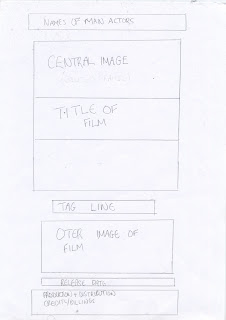A sample of people of all ages (over 15 of course) and genders were asked questions. These were their responses.
1. What sort of mise-en-scene to you associate with thrillers?
Weapons (mainly guns)
Suits - especially worn by the antagonist
Normal clothes (e.g. sweaters, t-shirts) - these worn to represent the normal people who are involved in thrillers.
2. When watching a teaser trailer what do you think the conventions are?
Production/Distribution Company Logos - for example Warner Brothers or Universal. This usually comes at the beginning.
Website (usually always at the end)
Voiceover man
Website (usually always at the end)
Voiceover man
Music - make sure that it reflects the genre but also that it works with images
Tagline
Tagline
Images from the film
Title of the film
Release dates (for a teaser this is likely to be 'Coming Soon' or something vague like this, rather than a specific date.
Indication of genre - the intended audience should be clear (this is done through the music, voiceover and mise-en-scene)
Title of the film
Release dates (for a teaser this is likely to be 'Coming Soon' or something vague like this, rather than a specific date.
Indication of genre - the intended audience should be clear (this is done through the music, voiceover and mise-en-scene)
Sound effects
Eye candy
Editing - transitions often include flashes, quick fades and dissolves alongside more conventional cutsEye candy
Possibly cast, crew, director credits
Possibly reference to other films (that this is similar to) or other films that have been directed/produced by the same people.
Stars / names of the stars
Reference to awards that cast/crew/film may have won or been nominated for (these may refer to other films).
3. When watching a teaser trailer what do you think are the conventions of a thriller teaser trailer?
Protagonist and girlfriend on the run together
Mise en scene - The protagonists are wearing suits
Impact sounds - Quick, high pitched
Mise en scene - The protagonists are wearing suits
Impact sounds - Quick, high pitched
Montages
Fight scenes
Slow temp music at the beginning, then fast music starts as it builds up to the end.
Taglines
Release Date
Fight scenes
Slow temp music at the beginning, then fast music starts as it builds up to the end.
Taglines
Release Date
Focus on guns
RunningCanted angles
Doors being closed and opened
Voiceover
Black screen with white writing (e.g. credits, title etc)
Eye candy
Extreme close ups
Match on actions
Credits/Billing
Sound logos
Logos of companies making films
Eye candy
Extreme close ups
Match on actions
Credits/Billing
Sound logos
Logos of companies making films
4. Which films do you think best represents the sub genre of political, on the run or conspiracy thriller?
The Bourne Identity
Unknown
The Adjustment Bureau
The Next Three Days
The Bourne Supremacy
The Bourne Ultimatum
The Ides Of March
Flight Plan
The Manchurian Candidate
The Interpreter
Vantage Point
I plan on using these answers in my research and planning into making a conventional thriller. I will use this as help for my own research into each of these questions on my blog. I will also create a questionnaire for the final copy of the film to see if I have matched these answers.























